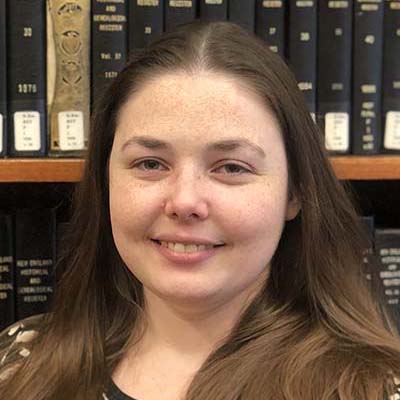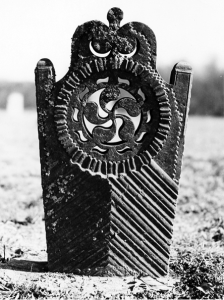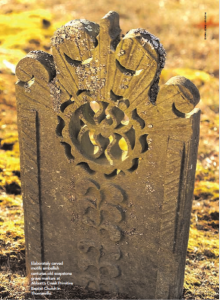At the North Carolinian Piedmont, in the cemeteries of Davidson County, sunlight breaks through perforated soapstone, creating a lattice-like design in the shadows cast by the many tombstones. These grave markers are probably the earliest “pierced” gravestones in North America. The stones themselves are stunning examples of craftsmanship. They quickly catch one’s eye, scattered between the plain grey stones cut in the minimalistic European style that is more common to this area.
[M]y 6th-great-grandfather
Joseph Clodfelter
is credited as the very first
gravestone carver of his kind.
While the creators of these stones hailed from Switzerland, the style is not native to that location. Pierced stones are an original creation found nowhere else in the world. It is rare that anyone can rightfully use the word “original”—but in this case, my 6th-great-grandfather Joseph Clodfelter is credited as the very first gravestone carver of his kind. He was one of very few individuals in the world to ever produce these works of art.
The Glattfelders
An extended family network of residents from the Feld der Glatt region of Zurich, Switzerland[1], immigrated to Pennsylvania in 1743.[2]This group, known as “the Glattfelders,” were a hodge-podge of loosely interrelated individuals, combined from the homes of several siblings, widows, their children, and cousins. The deaths of many of the male heads of household motivated one of the surviving men, Casper (or Gasper) Glattfelder, to migrate to America. His intention was to help provide a better future for the next generations of his family. Casper was generally acknowledged by historians to be the “head” of the family, though he was technically an uncle, great-uncle, or in-law to most of his herd. The Casper Glattfelder Association of America was organized in 1906, and a nonprofit was founded in 1910[3]to memorialize the man and the contributions of his descendants.
The Glattfelders spread slowly southward and westward from Pennsylvania, with a cluster settling permanently at Rowan County, North Carolina, around 1763.[4]They changed the spelling of the surname to Clodfelter, another aspect apparently unique to this clan. The Glattfelders/Clodfelters were descended from Swiss barrel makers and found a niche in their new community creating visually stunning and elaborately constructed wooden cabinets. Their style is now known as the Swisegood School (named after another branch of my early American ancestors who apprenticed and intermarried with the Clodfelters). The Swisegood School was notable for its scrolled pediments and intricate carved details.
Expanding the Business
To supplement their income In the early 1800s, the family began to produce caskets[5]. From this they expanded into the carving of grave markers. Utilizing the same tools as his cabinetmaker father[6]Jacob Clodfelter, my 6th-great-grandfather Joseph Clodfelter began to produce carved stone tablets for his neighbors and members of the Abbott’s Creek Primitive Baptist and Beck’s Reformed Churches. Historians and archeological researchers infer that Joseph’s style was influenced greatly by the Swisegood style of cabinet making practiced by his father. Joseph's "Pierced Style" tombstones were found to be an entirely unique design, having no precedent in Europe or the Americas.[7]
The stones, which began to appear in the early 19th century with simple inscribed symbols and designs, eventually exhibited complete incision through the body, or tympana of the stone. The earliest examples of fully pierced stones were found at the gravesites of Joseph’s grandparents, who died in 1813 and 1814. Scrolls also became a common design in these grave markers, mirroring the style of the cabinet makers of the Swisegood School. Joseph’s skill evolved through the decades, emerging into the “Mature Pierced Style” around the mid-to-late 1820s.[8]His later carvings included “elaborate sunburst pediments, pierced symbols and front, rear and side moldings. . . . These are the earliest [gravestones] in the county which are truly sculpture in the round, in contrast to the frontally oriented slabs of the English gravestone tradition.”[9] Inscribed tulips, hearts, and other shapes utilized negative space in a manner never seen before and never repeated outside of Davidson County.
New Discoveries
Looking back at other stones from this area, I found many in the Pierced Style for families that had no recorded connection to the Clodfelters. A digital exploration of the headstone images I’d collected helped uncover many previously overlooked relationships that I would have never suspected. The design of these gravestones in Joseph Clodfelter’s signature style led to some major discoveries in my own family history, which in turn has helped to verify connections to distant cousins and obscure DNA matches.
As with many families whose ancestors arrived in America prior to the 19th century, the information conveyed by inscribed tombstones is often all that remains of those who passed away. The fact that I can touch the stone and wooden carvings of my ancestors—to feel the pinnacle of a style of craftsmanship so unique to my family history—is a luxury to which few can relate. I can only dream of producing a body of work as indelible as theirs, but I am proud to share my heritage with these master craftsmen and hope to help preserve and memorialize their art for many years to come.
Notes
[1]Of Casper Glattfelder of Glattfelden, Canton Zurich, Switzerland, Immigrant, 1743, and of His Descendants, in Part, Comprising 861 Families (Glatfelter, 1901), p.3.
[2]Heritage of Rowan County, North Carolina Vol. 1 (Petrucelli, 1991), p.273.
[3]Casper Glattfelder Association of America: About Us; Link: https://glattfelder.us/en/about-us.html
[4]Museum of Early Southern Decorative Arts, Winston-Salem, North Carolina; Link: https://mesda.org/item/collections/corner-cupboard/1838/
[5]Museum of Early Southern Decorative Arts, Winston-Salem, North Carolina; Link: https://mesda.org/item/collections/corner-cupboard/1838/
[6]National Society of Daughters of the American Colonists, Early American Tombstones plaque located at Abbott’s Creek Primitive Baptist Church Cemetery; Image: https://images.findagrave.com/photos/2012/119/CEM2386134_133570029804.jpg
[7]National Register of Historic Places Digital Archive, Link: https://npgallery.nps.gov/NRHP/GetAsset/NRHP/64000444_text
[8]National Register of Historic Places Digital Archive, Link: https://npgallery.nps.gov/NRHP/GetAsset/NRHP/64000444_text
[9]National Register of Historic Places Digital Archive, Link: https://npgallery.nps.gov/NRHP/GetAsset/NRHP/64000444_text
Share this:

About Jennica Bayne
Jennica Bayne joined the Research Services team in 2019. In addition to Colonial New England and Eastern Canadian settlers, her personal research interests include early Quaker settlers of Virginia and North Carolina, their connections to the Underground Railroad, and their interactions with the Cherokee Nation, specifically the Eastern Band Cherokee. Jennica has a passion for data analysis and inheritance patterns, and she is proficient with a wide variety of genetic assessment tools and visual mapping techniques.View all posts by Jennica Bayne →

